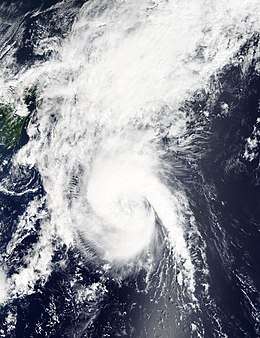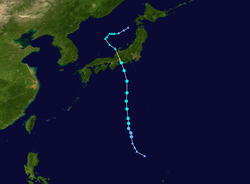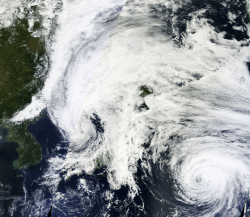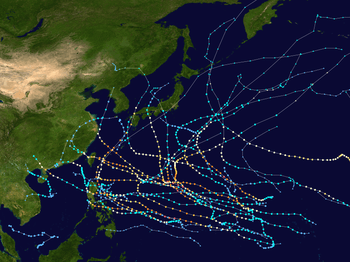Tropical Storm Etau (2015)
Severe Tropical Storm Etau caused extensive and destructive floods across eastern Japan during early September 2015. Originating from a tropical disturbance near Guam on September 2, Etau was first classified a tropical depression on September 5. Tracking generally north, the cyclone gradually intensified and reached its peak strength with winds of 95 km/h (60 mph) on September 8. The following day, Etau made landfall in Honshu, Japan. It subsequently transitioned into an extratropical cyclone later that day over the Sea of Japan.
| Severe tropical storm (JMA scale) | |
|---|---|
| Tropical storm (SSHWS) | |
 Tropical Storm Etau approaching Japan on September 8 | |
| Formed | September 6, 2015 |
| Dissipated | September 11, 2015 |
| (Extratropical after September 9) | |
| Highest winds | 10-minute sustained: 95 km/h (60 mph) 1-minute sustained: 110 km/h (70 mph) |
| Lowest pressure | 985 hPa (mbar); 29.09 inHg |
| Fatalities | 8 confirmed |
| Damage | $2.44 billion (2015 USD) |
| Areas affected | Japan (particularly eastern Honshu), Russian Far East |
| Part of the 2015 Pacific typhoon season | |
Record-breaking rains fell across Ibaraki and Tochigi prefectures, triggering destructive floods. Evacuation orders were issued to approximately 2.8 million people. Levee breaches took place along multiple rivers, most notably the Kinugawa which subsequently inundated the city of Jōsō. Eight people were killed across eastern Japan and total damage amounted to ¥294 billion (US$2.44 billion).[1]
Meteorological history

During September 5, the United States Joint Typhoon Warning Center started to monitor a tropical disturbance, that had developed within a marginal environment for further development to the northwest of Guam.[2] At this time the system was broad, weak and unorganized with deep atmospheric convection displaced over the north-western quadrant.[2] Over the next day the disturbance moved north-westwards, as its low level circulation developed further and started to consolidate.[3] During September 6, the system was classified as Tropical Depression 18W by the JTWC and as Tropical Storm Etau by the JMA.[4][5] However, during Etau's post storm analysis, the JMA announced that the system had only developed into a tropical storm during September 7.
Formative bands wrapped around its ragged and ill-defined LLCC.[6] Satellite image revealed that Etau had convection increasing near its center,[7] therefore, the JTWC upgraded it to a tropical storm.[8] The system later reached its peak intensity as a severe tropical storm on September 8 with maximum sustained winds of 95 km/h (60 mph).[9] Some weakening took place before the system made landfall over Chita Peninsula, Aichi, in the Chūbu region of Japan, early on September 9. Transition into an extratropical cyclone ensued as Etau became embedded within a frontal boundary.[10] This process completed later that day as Etau emerged over the Sea of Japan.[11] The extratropical remnants of Etau later interacted with and was absorbed by another but larger extratropical system which were the remnants of Typhoon Kilo on September 11.
Impact
Japan

Record rains fell across many areas in eastern Japan, with more than 12 in (300 mm) reported in much of eastern Honshu.[12] The JMA director, Takuya Deshimaru, called the event "unprecedented".[13] The heaviest rains fell across Tochigi Prefecture where 668 mm (26.3 in) was observed in Nikkō, including 551 mm (21.7 in) in 24 hours. Kanuma saw 444 mm (17.5 in) during 24 hours, more than double its previous record. Farther north in Sendai, 350 mm (14 in) of rain was observed.[12] Toba, Mie saw 75.5 mm (2.97 in) in an hour.[14] Fukushima Prefecture saw its heaviest rains in 50 years, with more than 300 mm (12 in) observed during a 48‑hour span.[15]
The extreme rains prompted multiple emergency warnings from the JMA and Takuya Deshimaru stated that the situation posed "grave danger" to residents.[16] An emergency rainfall warning was issued for Tochigi and Ibaraki prefectures on September 10 and for Miyagi Prefecture on September 11.[12] More than 90,000 people were placed under mandatory evacuation orders A further 700,000 people were advised to evacuate as of the morning of September 11,[12] including 410,000 in Sendai, Miyagi.[16] At the height of the storm, 600,000 people were advised to relocate across Kawasaki in Kanagawa Prefecture.[12] Overall, approximately 2.8 million people were advised to evacuate, with 183,500 people under mandatory orders.[17]
The heavy rains triggered widespread flooding, with multiple rivers over-topping their banks. A 140 m (460 ft) section of a levee along the Kinugawa River in Ibaraki collapsed shortly after noon local time on September 10,[16][18] inundating the nearby city of Jōsō.[16] An evacuation order was not issued for Jōsō until the levee was already breached; Mayor Toru Takasugi later issued a public apology for the delayed warning.[19] This was the first time the river broke its banks in 66 years. A 40 km2 (15 mi2) area with an estimated 6,500 homes and businesses was affected.[16][19] Residents were left stranded on rooftops,[16] with 880 still in need of rescue by the morning of September 11.[12] Two people died in the city.[19] Two other areas along the river, including Chikusei, experienced flooding.[18] Throughout Ibaraki Prefecture, 3,089 hectares (7,633 acre) of crops were damaged with losses exceeding ¥920 million (US$7.64 million).[20] One person died in Sakai.[21]
| External video | |
|---|---|
YouTube video |
At least one person was killed by a landslide in Kanuma, Tochigi.[13][16] Another landslide at a mine in Ashikaga killed a worker.[12] A third death in Tochigi occurred due to flooding.[22] Widespread flooding affected Miyagi Prefecture, especially around the town of Taiwa. A levee along the Shibui River in Ōsaki was breached, stranding 1,000 people.[12] Two people drowned across the prefecture.[13][23] A total of 4,533 hectares (11,201 acres) of farmland were submerged.[24] Landslides and flooding in Chiba Prefecture affected 109 buildings and rendered numerous roads impassible. Significant damage took place at a fishing port in Chōshi; multiple vessels sank and driftwood cluttered the water. Agricultural losses in the prefecture reached ¥84 million (US$698,000).[25]
Drainage pumps at the crippled Fukushima Daiichi Nuclear Power Plant, which suffered critical meltdowns after the 2011 Tōhoku earthquake and tsunami, were overwhelmed on September 9 and allowed contaminated water to flow into the Pacific Ocean. This was the seventh such incident in 2015.[13][26] Flood waters swept 293 bags of radioactive waste into a nearby river, 171 of which were retrieved by September 13.[19] More than 800 people were isolated in the mountain town of Minamiaizu after the Tateiwagawa River washed away the only highway access to the town.[12][18]
Damage across the Tōkai region, where Etau made landfall, was comparably light. A total of 108 homes were affected and landslides damaged multiple roads. Losses in the region reached ¥265 million (US$2.2 million).[27] An 800-year-old tree in Tarui, Gifu, a local natural monument, was felled from a combination of saturated soil and high winds produced by Etau.[28]
Russia
The extratropical remnants of Etau brought moderate rains to Primorsky Krai in the Russian Far East on September 10. Accumulations peaked at 73 mm (2.9 in) with values over 50 mm (2.0 in) limited to coastal areas. Winds up to 79 km/h (49 mph) were observed in Vladivostok.[29]
Aftermath
The Japan Self-Defense Forces dispatched helicopters to Jōsō soon after the floods, rescuing people from rooftops.[12] More than 6,000 personnel and 51 helicopters were deployed. Rescuers were reportedly overwhelmed by the number of calls for help.[13] A rescue attempt of a couple in Jōsō was aired live; however, the structure they were standing on collapsed and the feed was cut and their fate is currently unknown.[12] The Metropolitan Police Department in Tokyo planned to send 100 officers to Jōsō while members of the Tokyo Fire Department were deployed with a helicopter.[16] Lingering high waters from the levee breach hampered relief efforts. Prime Minister Shinzō Abe toured Jōsō on September 12.[30] By September 13, approximately 2,100 people from Jōsō remained in public shelters.[19] The Japanese Red Cross provided ¥3 million (US$25,000) to relief efforts and asked the public for donations.[31]
See also
References
- "平成 27 年の水害被害額(確報値)を公表" (PDF) (in Japanese). Ministry of Land, Infrastructure, Transport and Tourism. March 22, 2017. Retrieved July 13, 2017.
- "Significant Tropical Weather Advisory for the Western and South Pacific Oceans September 5, 2015 06z". United States Joint Typhoon Warning Center. Archived from the original on September 5, 2015. Retrieved August 8, 2015.
- "Significant Tropical Weather Advisory for the Western and South Pacific Oceans September 6, 2015 06z". United States Joint Typhoon Warning Center. Archived from the original on September 5, 2015. Retrieved August 8, 2015.
- https://www.webcitation.org/6bLo50v8Q?url=http://gwydir.demon.co.uk/advisories/WTPN32-PGTW_201509062100.htm
- https://www.webcitation.org/6bLniaE0s?url=http://gwydir.demon.co.uk/advisories/WTPQ21-RJTD_201509061800.htm
- "Prognostic Reasoning Tropical Depression 18W (Eighteen) Warning Nr 01". Joint Typhoon Warning Center. Archived from the original on September 6, 2015. Retrieved September 6, 2015.
- "Prognostic Reasoning Tropical Depression 18W (Etau) Warning Nr 03". Joint Typhoon Warning Center. Archived from the original on September 7, 2015. Retrieved September 7, 2015.
- "Tropical Storm 18W (Etau) Warning Nr 04". Joint Typhoon Warning Center. United States Navy. September 7, 2015. Archived from the original on September 7, 2015. Retrieved September 11, 2015.
- "RSMC Tropical Cyclone Advisory". Japan Meteorological Agency. September 8, 2015. Archived from the original on September 9, 2015. Retrieved September 11, 2015.
- "Prognostic Reasoning for Tropical Storm 18W (Etau) Warning Nr 10". Joint Typhoon Warning Center. United States Navy. September 9, 2015. Archived from the original on September 9, 2015. Retrieved September 11, 2015.
- "RSMC Tropical Cyclone Advisory". Japan Meteorological Agency. September 9, 2015. Archived from the original on September 9, 2015. Retrieved September 11, 2015.
- Nick Wiltgen (September 10, 2015). "Japan Issues Third Emergency Warning as Flood, Landslide Dangers Spread North; At Least 1 Dead, 25 Missing". The Weather Channel. Retrieved September 11, 2015.
- "Japan floods: Rescue work continues after deadly disaster". British Broadcasting Corporation. September 11, 2015. Retrieved September 11, 2015.
- "Typhoon Etau pummels Japan with gales, heavy rain; evacuations ordered". Jiji Press, Kyodo News. The Japan Times. September 9, 2015. Retrieved September 11, 2015.
- Will Ripley & Euan McKirdy (September 11, 2015). "Japan flooding: 3 deaths, dozens missing in deluge". Tokyo, Japan: CNN. Retrieved September 11, 2015.
- "Rescue operations continue in flooded Ibaraki city; 22 missing". Kyodo News. Tokyo, Japan: Japan Today. September 11, 2015. Retrieved September 11, 2015.
- Yoko Wakatsuki; Will Ripley & Katie Hunt (September 12, 2015). "Japan flooding: 2.8 million advised to evacuate". Jōsō, Japan: CNN. Retrieved September 13, 2015.
- "Storm flood rips through residential neighborhood; helicopters pull survivors from collapsing homes". Jiji Press, Kyodo News, Associated Press. Japan Today. September 10, 2015. Retrieved September 11, 2015.
- "More than 3,000 residents of Joso remain evacuated after devastating floods; death toll hits 7". Jiji Press, Kyodo News, Agence France-Presse. The Japan Times. September 13, 2015. Retrieved September 14, 2015.
- "茨城県の農産物3000ha超で被害-台風18号被害". Japan Agricultural Communications (in Japanese). Nokyokyoukai. September 14, 2015. Archived from the original on September 14, 2015. Retrieved September 14, 2015.
- "Joso braces for more rain as death toll from flood rises to eight". Jiji Press, Kyodo News. Mito, Japan: The Japan Times. September 17, 2015. Retrieved September 18, 2015.
- "Death toll rises to five after Japan flood: Media". Agence France-Presse. Tokyo, Japan: The Straits Times. September 13, 2015. Retrieved September 13, 2015.
- "Abe visits flood-hit city as rescue efforts go on". Agence France-Presse. Jōsō, Japan: The Straits Times. September 13, 2015. Retrieved September 13, 2015.
- "農作物被害4533ヘクタールに 畜舎浸水13カ所 大雨で宮城県". 日本農業新聞 (in Japanese). Yahoo! News. September 14, 2015. Archived from the original on September 14, 2015. Retrieved September 14, 2015.
- "東日本豪雨 千葉県の農林水産業被害額8400万円 8カ所でがけ崩れ". 産経新聞 (in Japanese). Yahoo! News. September 12, 2015. Archived from the original on September 13, 2015. Retrieved September 13, 2015.
- "福島第1原発:汚染水が外洋流出 7回目" (in Japanese). 毎日新聞. September 9, 2015. Retrieved September 11, 2015.
- "三重)台風18号、県内土木施設の被害2億6500万円" (in Japanese). 朝日新聞. September 12, 2015. Archived from the original on September 14, 2015. Retrieved September 14, 2015.
- "垂井の大ケヤキ倒れた 樹齢800年、宿場町のシンボル 住民ショック、台風影響か". 岐阜新聞 (in Japanese). Yahoo! News. September 12, 2015. Archived from the original on September 14, 2015. Retrieved September 14, 2015.
- "Экс-тропический шторм "Атау" обрушил на Приморье очень сильный дождь" (in Russian). Gismeteo. September 10, 2015. Retrieved September 11, 2015.
- Harumi Ozawa (September 12, 2015). "Japan PM visits flood-hit Joso as rescuers search for missing". Yahoo! News. Jōsō, Japan. Agence France-Presse. Archived from the original on September 14, 2015. Retrieved September 14, 2015.
- "ANA、茨城・栃木の大雨被災者を支援…マイル寄付も呼びかけ". response.jp. September 14, 2015. Archived from the original on September 14, 2015. Retrieved September 14, 2015.
External links
| Wikimedia Commons has media related to Severe Tropical Storm Etau (2015). |
- JMA General Information of Severe Tropical Storm Etau (1518) from Digital Typhoon
- JMA Best Track Data of Severe Tropical Storm Etau (1518) (in Japanese)
- 18W.ETAU from the U.S. Naval Research Laboratory

